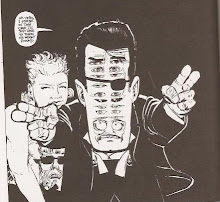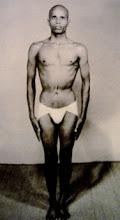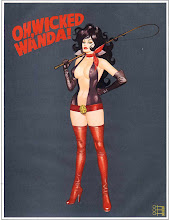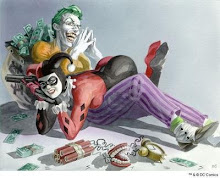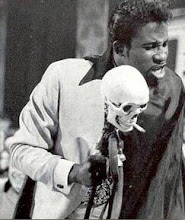 A comic I did in Seattle about centering. To me the most important aspect of yoga practice.
A comic I did in Seattle about centering. To me the most important aspect of yoga practice.Om SHAnti SHAnti SHAnti and BE HERE NOW
 The best comic series that I've read recently was Eddie Campbell's Bacchus. I was introduced to Eddie Campbell's work in From Hell. Bacchus is based at the core upon Greek Mythology, Campbell updated the characters with one basic assumption: the gods aren't wholly immortal, they can die, they can age.
The best comic series that I've read recently was Eddie Campbell's Bacchus. I was introduced to Eddie Campbell's work in From Hell. Bacchus is based at the core upon Greek Mythology, Campbell updated the characters with one basic assumption: the gods aren't wholly immortal, they can die, they can age. old sea captain, wearing a captain's cap and pea coat. He survives on wine and spirits. He won't touch food or water. He also won't touch ale. He has lost an eye due to a corkscrew accident with the abbot Dom Perignon. He is a drifter, and the series begins and ends with him in a jail cell. He is no longer the fair haired youth of Euripides' Bacchae. He is taunted and seems a weak, pathetic, old man. But as in Bacchae he is a savage force to be reckoned with.
old sea captain, wearing a captain's cap and pea coat. He survives on wine and spirits. He won't touch food or water. He also won't touch ale. He has lost an eye due to a corkscrew accident with the abbot Dom Perignon. He is a drifter, and the series begins and ends with him in a jail cell. He is no longer the fair haired youth of Euripides' Bacchae. He is taunted and seems a weak, pathetic, old man. But as in Bacchae he is a savage force to be reckoned with.
 aring god. Simpson is also the undead. He was taken to Hades due to a clerical error, by Hermes. He managed to escape though and serves as the twice born's only surviving worshiper.
aring god. Simpson is also the undead. He was taken to Hades due to a clerical error, by Hermes. He managed to escape though and serves as the twice born's only surviving worshiper.
 , but because he abandoned Ariadne after she helped him defeat the Minotaur. After leaving her on an island, the god Bacchus took her as his wife, but she eventually died. Joe Theseus is handsome and strong. He has a full head of hair, a beard, and is a financial whiz. He is the enemy of Bacchus. Joe Theseus has a wild card of an ally in the form of the Eyeball Kid.
, but because he abandoned Ariadne after she helped him defeat the Minotaur. After leaving her on an island, the god Bacchus took her as his wife, but she eventually died. Joe Theseus is handsome and strong. He has a full head of hair, a beard, and is a financial whiz. He is the enemy of Bacchus. Joe Theseus has a wild card of an ally in the form of the Eyeball Kid. There is no reasoning with the Eyeball Kid. Of all the insane characters in the Bacchus universe, he has the least grip on reality. He has gone crazy on power. The power of his immortality and the power of the lightning that he has in his hands. Joe Theseus may only be aligned with him due to the fact that he
There is no reasoning with the Eyeball Kid. Of all the insane characters in the Bacchus universe, he has the least grip on reality. He has gone crazy on power. The power of his immortality and the power of the lightning that he has in his hands. Joe Theseus may only be aligned with him due to the fact that he 's afraid of what the Eyeball Kid is capable of.
's afraid of what the Eyeball Kid is capable of.

 t they craved. Lord knew that there was a market for the comics prior to their ban. In 1958 Forrest Ackerman created, with the publisher James Warren, Famous Monsters of Filmland. The reason that they were able to publish a magazine that featured terrifying monsters and horrific stories was because it was a magazine. The Comics Code only had jurisdiction over comic books. A little loophole gave Ackerman the ability to expose a new generation of kids to the horror movies that he so loved as a kid. The original Famous Monsters of Filmland ran for 25 years, covering numerous contemporary horror movies as well as the classics. The magazine also had short horror comics in them.
t they craved. Lord knew that there was a market for the comics prior to their ban. In 1958 Forrest Ackerman created, with the publisher James Warren, Famous Monsters of Filmland. The reason that they were able to publish a magazine that featured terrifying monsters and horrific stories was because it was a magazine. The Comics Code only had jurisdiction over comic books. A little loophole gave Ackerman the ability to expose a new generation of kids to the horror movies that he so loved as a kid. The original Famous Monsters of Filmland ran for 25 years, covering numerous contemporary horror movies as well as the classics. The magazine also had short horror comics in them.
 the covers for Vampirella and other artists drew the interiors. Vampirella differed from the traditional vampire in that she was from another planet, a planet completely inhabited by vampires. The name of the planet was Draculon. Vampirella was also different in the fact that she was a heroine who came to earth to punish evil vampires from her home planet who crashed on Earth and were running amok. This new science fiction version of a vampire was something that had never been seen before in vampire mythos. In the Vampirella comic there were several other horror stories along with the continuing story of Vampirella herself.
the covers for Vampirella and other artists drew the interiors. Vampirella differed from the traditional vampire in that she was from another planet, a planet completely inhabited by vampires. The name of the planet was Draculon. Vampirella was also different in the fact that she was a heroine who came to earth to punish evil vampires from her home planet who crashed on Earth and were running amok. This new science fiction version of a vampire was something that had never been seen before in vampire mythos. In the Vampirella comic there were several other horror stories along with the continuing story of Vampirella herself.







 Phillip is one such donor. He is a stripper at Guilty Pleasures, a male vampire strip club. He is addicted to the bite and willingly submits to a wide variety of vampires, hence the scars. He is the main romantic interest of Anita in Guilty Pleasures.
Phillip is one such donor. He is a stripper at Guilty Pleasures, a male vampire strip club. He is addicted to the bite and willingly submits to a wide variety of vampires, hence the scars. He is the main romantic interest of Anita in Guilty Pleasures.



 The last part of the alternate reality of Anita Blake's that I think is so cool is the ghouls. Instead of having ghouls that are tied to a master vampire, ghouls are demon beasts that have a resurrector for their master. Ghouls are created when a reanimator dies and is resurrected. Ghouls generally live in cemetaries and rip apart any living thing that they encounter. They cannot live in cemeteries that are consecrated. It is possible that a resurrector that is reanimated will have as many ghouls as zombies that he resurrected in his lifetime.
The last part of the alternate reality of Anita Blake's that I think is so cool is the ghouls. Instead of having ghouls that are tied to a master vampire, ghouls are demon beasts that have a resurrector for their master. Ghouls are created when a reanimator dies and is resurrected. Ghouls generally live in cemetaries and rip apart any living thing that they encounter. They cannot live in cemeteries that are consecrated. It is possible that a resurrector that is reanimated will have as many ghouls as zombies that he resurrected in his lifetime.
















